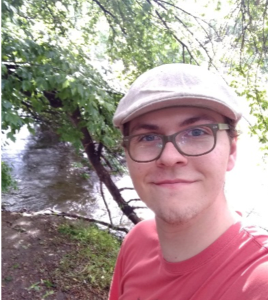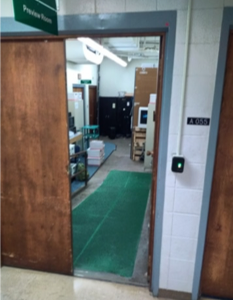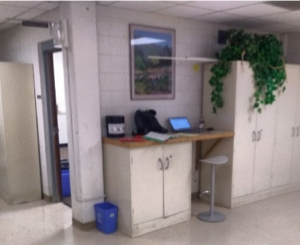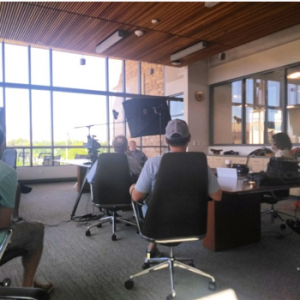Internship: With Frank Boring through Morgan Library on the CSU150 Documentary Film Project
Faculty Advisor: Dr. Thomas Cauvin | Intern: Charlie Dreyer | Semester: Summer 2019

The path that led me to the internship started when I decided to try to learn about public History by taking a class about museums with Professor Pedersen-Guzman. This museum class started taking tours of a bunch of museums. Looking behind the scenes got me thinking about volunteering at such places, so I could get some experience in History as a practice rather than just as a study. In this effort, I started volunteering at Professor Pedersen-Guzman’s own Archaeological Collections Repository, where I came weekly to try to prove the consistency of my work ethic which she and my own life experience had taught me was critical.
In order to better learn how to convert an understanding of History into a form comprehensible to people who go in with little to no knowledge of the subject, I decided to take Dr. Thomas Cauvin’s course on Historical Media Production. Early in the semester, the perfect opportunity came to both learn and experience History when Frank Boring and Bryan Rayburn came to the class to talk about how CSU would be turning 150 in 2020 and how they were making a documentary film about it. They had found more than 8000 old videos of CSU’s History to go through while looking for materials and had brought some highlights from those to show off. After class ended, I chased down Frank and Bryan and asked if they had any need for a volunteer. They brought me down into the basement of Clark A, near where I’d been volunteering for the Archaeological Collections Repository into what I would learn is called the Ramp Room. In that room Bryan explained how to operate this machine that was kind of like a VCR player on steroids in order to play these huge VCR like tapes, then to take notes about them on a form. The process took about an hour at first. For the rest of the semester, I came every day I could for about 50 to 90 minutes, getting more efficient as I got used to the process.
One day Frank brought me into his office to ask what my career plans were. I told him that I planned on getting what experience I could then graduating and getting some on-the-job-style experience, like an internship, before continuing on to further education. To my surprise, he asked if I’d like to do a historical research internship that upcoming summer. It turned out, of all the hundreds of History students he had talked to, I had been the only one to come to the ramp room to volunteer and was able to impress him with the consistency of my presence there.
After that conversation with Frank, he started me in on new work with my new counterpart the video production intern Mat Huck, whom had set up a spreadsheet where he and now I worked on finding information about people who Frank would possibly be interviewing in the future. These were former Staff and Alumni who were likely to know about important times and issues at the college. We were tasked with determining if and where they lived and finding contact information. While working on this project, I continually found interesting information about these people such as how one, a soldier, hid his uniform in a paper bag while walking around campus to avoid trouble that wearing it would have caused in the 1960s. Having decided that I could not simply throw such interesting information away, I made a timeline out of a spreadsheet in order to try to understand the events going on at the college and in peoples lives chronologically. This spreadsheet slowly expanded into the CSU150 Research Timeline as I added bits to it from every other project I worked on, slowly expanding its purpose and scope, and is currently the thing I’ve spent the most time on during the internship.
Three things were definitive of the first half of the internship. Firstly was what I call the Big Brain Storming Meetings (BBM) at the first of which I learned what my job as the research intern would be. Going in, I had believed my job would be to write research papers on various subjects relevant to CSU History. In that meeting, I learned that my role was not to write papers but to collect information into one comprehensible mega source as efficiently as possible so that others could write the paper, or in this case the script. I was to do research. All the rest involved in paper writing was not my task and would only take time that I should be using on research. Truly a revelation to someone so used to writing essays and reports.
The second thing was the type of research I was doing. Defined by heavy use of a 1000 page PDF full of information about the college throughout its History made by Hap Hazard, a retired and now volunteering worker in Morgan Library’s Special Collections. As well as “Democracy’s College in the Centennial State: A History of Colorado State University” a book by James E. Hansen who pulled off a miracle in organizing the historical records which were just kind of scattered around campus and turning that into a coherent history of the college. I would use these as a baseline for research projects such as Indians and Larimer County where I was tasked to find any information I could about the relationships between Indians, Whites, and the land of the South Platte Basin.
The last thing that I was struck by at the BBM, which defined the first half of the internship, was the near lack of creative hierarchy. It quickly became clear, I was in that meeting with people far more experienced than myself, and despite that, I was expected to have the initiative to speak up when I knew something or had an idea. Far from the meeting where Frank would direct people to some tasks, and I would stay quiet, this was a discussion which I was involved in over the very narrative of the Documentary itself.
 During my time at the internship, I was invited to 3 of the interviews, which most of the other members of the project would attend. At these, I was assigned the duty of observing and thinking of questions for Frank to ask. While observing, I learned from Frank’s interviewing style how to lead people towards the topic you want them to tell you about in an organic way. Also, through these observations and conversation with Frank, I learned that the best way to interest someone in something they know little about, rather than trying to awe them with completely new information, is to connect the thing to what they do know then move out from there, a tactic I’ve been trying to use on projects since.
During my time at the internship, I was invited to 3 of the interviews, which most of the other members of the project would attend. At these, I was assigned the duty of observing and thinking of questions for Frank to ask. While observing, I learned from Frank’s interviewing style how to lead people towards the topic you want them to tell you about in an organic way. Also, through these observations and conversation with Frank, I learned that the best way to interest someone in something they know little about, rather than trying to awe them with completely new information, is to connect the thing to what they do know then move out from there, a tactic I’ve been trying to use on projects since.
As I got more used to my responsibilities, the tasks became more open and more self-defined. A good example of this is A Chronological List of CSU’s Firsts where me and for a time Mat Huck found things which happened first at CSU, notably the things we did before CU as well as the internal CSU Firsts. Pretty much any kind of thing could be put on this list, so the research I did was very broad and self-determined. That sort of project extended for the rest of the summer. Another notable example was when Frank discovered that I had been passively adding to the CSU150 Research Timeline, and he instructed me to focus on it, especially on the population data which I had found. This resulted in me spending several days digging through census data to find some specific data points. This was a new experience for me as usually for projects such as this, I simply use the data others have collected, but for once I had the experience of collecting it from the source myself.
Throughout my time both volunteering and interning with the CSU150 project, I have found myself learning new and interesting History, gaining new skills, and improving my ability to convey information to others in a positive and enjoyable manner. This being exactly my goal, I would say that this internship has been a success, and I look forward to working further on the project as a volunteer or anything else.